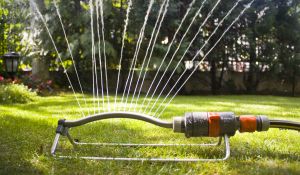ONE GARDENER TO ANOTHER: Conserving water in the garden
Published 6:45 am Monday, July 2, 2018

- Garden sprinkler
When my water bill arrives each month, I have a mini heart attack and am absolutely positive I have a leak somewhere.
I know, in part, it is because I have a teenage athlete in the house who showers a few times a day and causes an abundance of laundry. This has me putting my foot down about the duration of showers and pointing out that clothing worn for an hour around the house after said shower can be worn again.
Crazy, I know.
After lecturing my rolling-eyed child, I happily go out to the garden, turn on the sprinklers, grab the garden hose and give my flora a nice long shower. Not only is that not fair, it’s wasteful. Although we are very fortunate here in Alabama to receive decent rainfall, averaging approximately 5 inches a month, that doesn’t help all the plants in the garden. I very rarely need to turn on the sprinklers for the lawn, but I definitely need to water my container plants on a regular basis.
There is always a chance God’s shower might not get turned on for a while, as happened two years ago, and we will experience drought conditions. Efficient watering techniques and conservation, especially during periods of drought, are essential to prevent straining the water supply and causing shortages of ground water and streams.
Ways to conserve
There are a few ways to conserve water in the garden while keeping plants happily hydrated and blooms bursting.
Mulch. I don’t think I have written an article about the care of any given plant or shrub without mentioning mulch. Mulching helps retain water and maintain soil temperature in garden beds, but it will also achieve this for container plants.
Organic matter, or compost, added to soil in container plants acts as a sponge that hold water. Vermiculite can be added to potting soil or purchased already in potting soil. Vermiculite swells with water and shrinks as it dries, helping aerate the soil.
Water-saver plants
Which plants find a home in your garden and how they are arranged goes a long way in conserving water. Drought-resistant plants, as the name implies, require less frequent watering. This is not to say they don’t need any water; they are just a little more tolerant of a little less water.
When establishing a garden, hydrozones, created by grouping plants by their water needs, will keep you from frequently watering plants that do not require as much water simply because they are beside plants that do.
Irrigation
In established gardens, drip irrigation systems allow you to direct water to areas or specific plants based on their water needs. This also helps control weeds. Weeds tend to pop up in between plants. If the soil between plants or rows of vegetables is dry, it is not a breeding ground for unwanted infiltrators. Remember to remove weeds as they appear because they compete with plants for water.
Overhead sprinkler systems are often set on timers. This set-it-and-forget-it style watering often leads to overwatering. Such a system doesn’t know it is raining at 6:30 a.m. while you are driving to work. Overwatering also leads to runoff, which happens when the soil cannot absorb the water at the rate at which it is being applied.
Sprinklers set to reach all areas of the yard or garden sometimes end up watering the sidewalk, which just isn’t going to grow no matter how much you water it.
Water collection, using rain barrels, is like catching pennies from the sky. Rain barrels can be purchased “ready to use” or can be an easy DIY project. Conserving water is smart business not only for the wallet but also the environment.
Until next week, happy gardening.
— Irland, a member of the Limestone County Master Gardeners, can be reached at kippirland@hotmail.com. For more information on the Limestone County Master Gardeners, visit http://mg.aces.edu/limestone.





